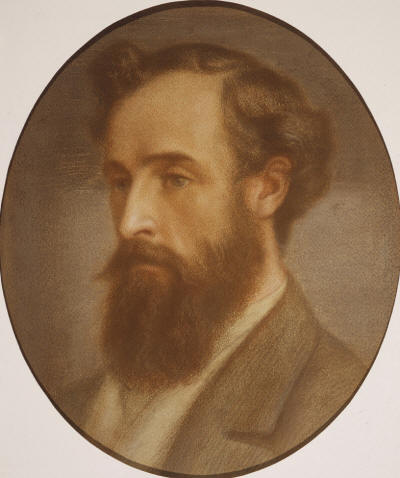

Queer Places:
King's College School, Southside, Wimbledon Common, Wimbledon, London SW19 4TT, Regno Unito
Royal Academy of Arts, Burlington House, Piccadilly, Mayfair, London W1J 0BD, Regno Unito
16 Cheyne Walk, Chelsea, London SW3 5RA, Regno Unito
110 Hallam St, Marylebone, London W1W, Regno Unito
17 Red Lion Square, London WC1R, Regno Unito
All Saints, Birchington-on-Sea, Regno Unito
 Gabriel Charles Dante Rossetti (12 May 1828 – 9 April 1882),
generally known as Dante Gabriel Rossetti,[1]
was a British poet, illustrator, painter and translator. He founded the
Pre-Raphaelite Brotherhood in 1848 with
William Holman Hunt and
John Everett Millais. Rossetti was later to be the main inspiration for a
second generation of artists and writers influenced by the movement, most
notably
William Morris and
Edward Burne-Jones. His work also influenced the European
Symbolists and was a major precursor of the
Aesthetic movement.
Gabriel Charles Dante Rossetti (12 May 1828 – 9 April 1882),
generally known as Dante Gabriel Rossetti,[1]
was a British poet, illustrator, painter and translator. He founded the
Pre-Raphaelite Brotherhood in 1848 with
William Holman Hunt and
John Everett Millais. Rossetti was later to be the main inspiration for a
second generation of artists and writers influenced by the movement, most
notably
William Morris and
Edward Burne-Jones. His work also influenced the European
Symbolists and was a major precursor of the
Aesthetic movement.
Rossetti's art was characterised by its sensuality and its medieval revivalism. His early poetry was influenced by John Keats. His later poetry was characterised by the complex interlinking of thought and feeling, especially in his sonnet sequence, The House of Life. Poetry and image are closely entwined in Rossetti's work. He frequently wrote sonnets to accompany his pictures, spanning from The Girlhood of Mary Virgin (1849) and Astarte Syriaca (1877), while also creating art to illustrate poems such as Goblin Market by the celebrated poet Christina Rossetti, his sister.
Rossetti's personal life was closely linked to his work, especially his relationships with his models and muses Elizabeth Siddal, Fanny Cornforth and Jane Morris.

Frederick Richards Leyland
by Dante Gabriel Rossetti
The savage reaction of critics to Rossetti's first collection of poetry contributed to a mental breakdown in June 1872, and although he joined Jane Morris at Kelmscott that September, he "spent his days in a haze of chloral and whisky".[49] The next summer he was much improved, and both Alexa Wilding and Jane sat for him at Kelmscott, where he created a soulful series of dream-like portraits.[49] In 1874, Morris reorganised his decorative arts firm, cutting Rossetti out of the business, and the polite fiction that both men were in residence with Jane at Kelmscott could not be maintained. Rossetti abruptly left Kelmscott in July 1874 and never returned. Toward the end of his life, he sank into a morbid state, darkened by his drug addiction to chloral hydrate and increasing mental instability. He spent his last years as a recluse at Cheyne Walk.
On Easter Sunday, 1882, he died at the country house of a friend, where he had gone in a vain attempt to recover his health, which had been destroyed by chloral as his wife's had been destroyed by laudanum. He died of Bright's Disease, a disease of the kidneys from which he had been suffering for some time. He had been housebound for some years on account of paralysis of the legs, though his chloral addiction is believed to have been a means of alleviating pain from a botched hydrocele removal. He had been suffering from alcohol psychosis for some time brought on by the excessive amounts of whisky he used to drown out the bitter taste of the chloral hydrate. He is buried at Birchington-on-Sea, Kent, England.[50] His grave is visited by admirers of his life's work and achievements as seen by fresh flowers placed there regularly.
My published books: